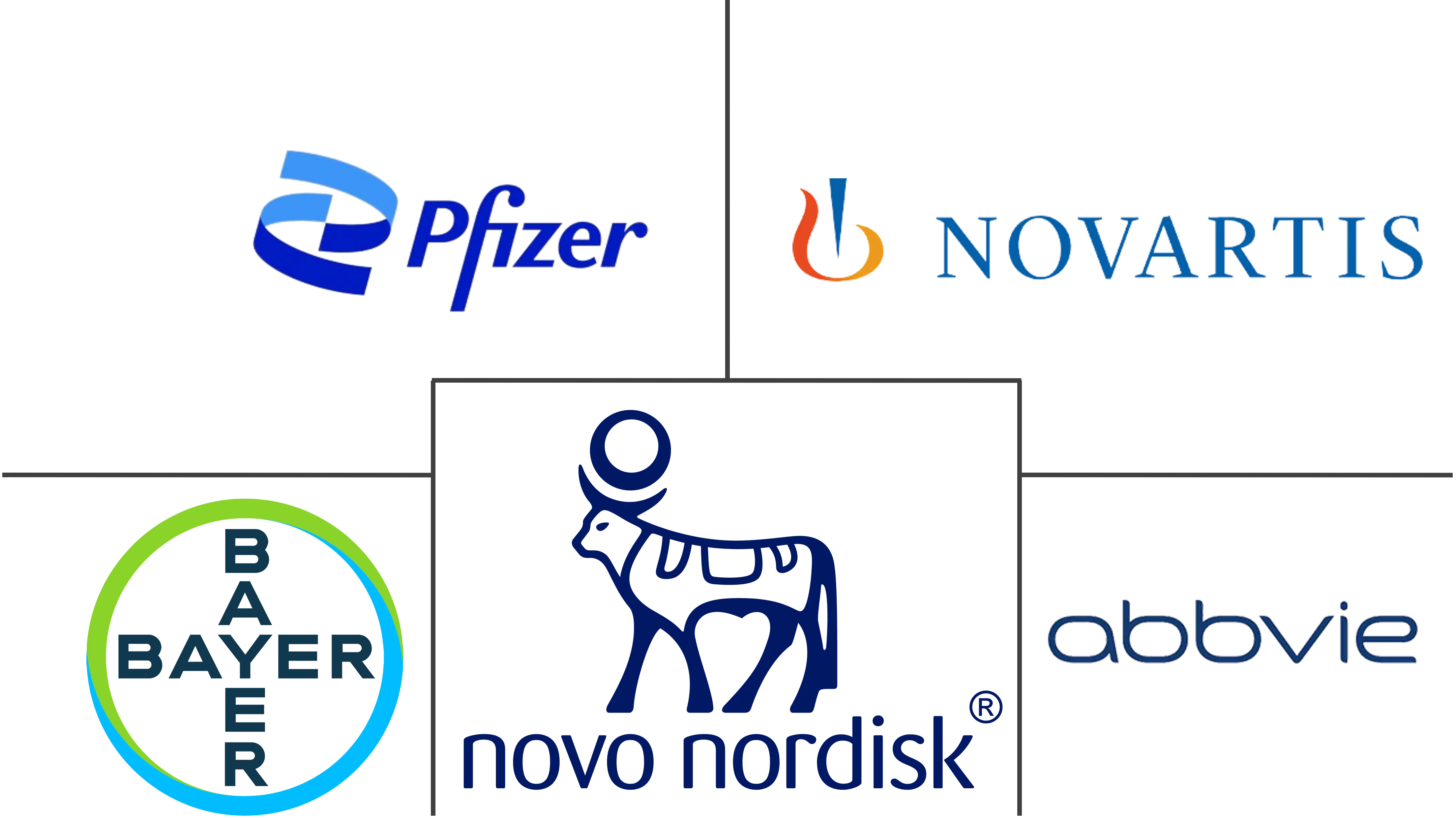Menopausal Hot Flashes Market Size and Share
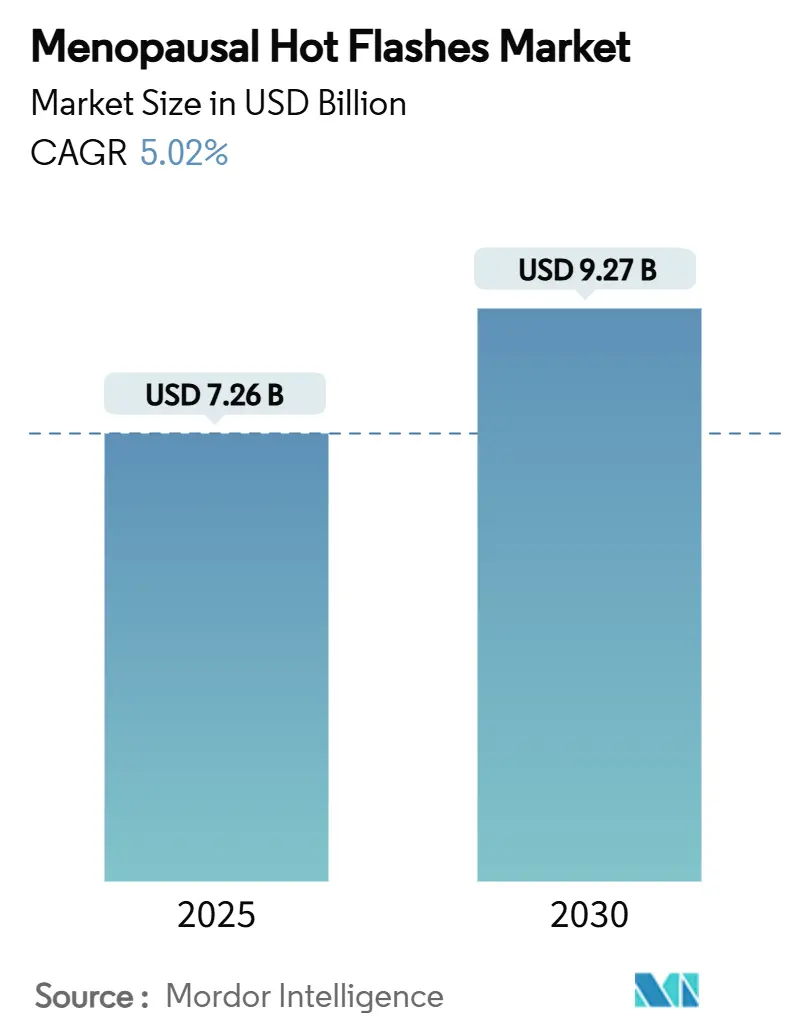
Menopausal Hot Flashes Market Analysis by Mordor Intelligence
The menopausal hot flashes market size reached USD 7.62 billion in 2025 and is projected to climb to USD 9.27 billion by 2030, translating into a 5.02% CAGR over the forecast window; the menopausal hot flashes market size outlook therefore reflects steady mid-single-digit expansion anchored in demographic momentum, therapeutic innovation, and widening access pathways. Growing life expectancy is adding millions of women to the symptomatic pool each year, while first-in-class NK-3 receptor antagonists and smarter hormone delivery systems are broadening the clinical tool kit. At the same time, digital prescription fulfillment, employer-backed wellness programs, and regulatory clarity around neurokinin blockers are flattening traditional access barriers, allowing the menopausal hot flashes market to move from episodic care toward proactive symptom management. Competitive intensity is rising as multinational firms race to secure first-mover advantage in non-hormonal categories, yet supply-chain investments and partnership models are also improving therapy availability in mid-income economies. Collectively, these forces reinforce a demand curve that is largely decoupled from macroeconomic cycles and position the menopausal hot flashes market for sustained top-line growth.
Key Report Takeaways
- By treatment type, hormonal therapy led with 54.23% of menopausal hot flashes market share in 2024, while non-hormonal therapy is forecast to expand at a 7.54% CAGR through 2030.
- By route of administration, oral formats accounted for 48.65% of the menopausal hot flashes market size in 2024; transdermal delivery is advancing at a 7.65% CAGR to 2030.
- By distribution channel, retail pharmacies captured 46.23% revenue share in 2024, whereas online pharmacies are projected to rise at an 8.23% CAGR during the same period.
- By menopausal stage, post-menopause represented 68.54% of demand in 2024, while the perimenopause segment is set to grow at a 7.85% CAGR through 2030.
- By geography, North America held 42.54% of the menopausal hot flashes market in 2024; Asia-Pacific is on track for the fastest regional CAGR of 6.45% to 2030.
Global Menopausal Hot Flashes Market Trends and Insights
Driver Impact Analysis
| Driver | % Impact on CAGR Forecast | Geographic Relevance | Impact Timeline |
|---|---|---|---|
| Rising post-menopausal population base | +1.7% | North America, Europe, Asia-Pacific | Long term (≥4 years) |
| Growing pharmaceutical investment in women’s health | +1.4% | North America, Europe | Medium term (2-4 years) |
| Advancements in non-hormonal therapeutics | +1.2% | Global, early adoption in U.S. and EU | Medium term (2-4 years) |
| Expansion of digital direct-to-consumer care platforms | +1.0% | U.S., U.K., Australia, urban APAC | Short term (≤2 years) |
| Inclusion of menopause care in corporate wellness plans | +0.8% | U.S., Western Europe, select APAC multinationals | Short term (≤2 years) |
| Adoption of personalized hormone delivery technologies | +0.6% | North America, Europe | Long term (≥4 years) |
| Source: Mordor Intelligence | |||
Rising Post-Menopausal Population Base
The global post-menopausal cohort is projected to touch 1.2 billion women by 2030, guaranteeing a long-run expansion corridor for the menopausal hot flashes market[1]World Health Organization, “Global Ageing and Health,” who.int. Extended life expectancy and later childbearing have stretched the post-menopausal window, increasing symptomatic years and therapy needs. In Japan, productivity data show 9% of women in their 40s and 50s leaving the workforce due to unmanaged vasomotor symptoms, underscoring economic stakes that go beyond clinical care. U.S. analyses estimate USD 1.8 billion in annual absenteeism linked directly to hot flashes, motivating employers to add menopause care to wellness budgets. Because demographic pressure operates independently of therapeutic breakthroughs, it gives the market a durable floor even when innovation cycles slow. As a result, capacity planning for drug production and digital support services has become a strategic imperative for suppliers seeking first-call status with payers and corporate buyers.
Growing Pharmaceutical Investment in Women’s Health
Between 2018 and 2023 venture funding for women’s health startups rose 314%, funneling capital toward non-hormonal R&D, specialized telehealth networks, and smart-patch technologies. Public-company commitments mirror this trend: Bayer values elinzanetant at USD 1 billion in peak sales potential, while Astellas targets USD 2.2-3.4 billion for fezolinetant. M&A activity is also heating up as firms acquire late-stage assets to offset patent cliffs; Cosette Pharmaceuticals’ USD 430 million purchase of Mayne Pharma’s women’s health division exemplifies this consolidation wave. Collectively, capital inflows have shortened development timelines, accelerated multi-center trials, and increased the probability of combo-therapy launches that could expand both adherence and pricing power inside the menopausal hot flashes market.
Advancements in Non-Hormonal Therapeutics
The FDA’s 2023 approval of fezolinetant validated NK-3 receptor antagonism as a first-in-class pathway, reducing hot-flash frequency by as much as 65% within 12 weeks of therapy initiation[2]U.S. Food and Drug Administration, “Fezolinetant Approval Letter,” fda.gov. Elinzanetant, now under FDA review, adds dual NK-1/NK-3 activity and has demonstrated superior sleep-quality scores versus placebo, positioning it as a potential category benchmark. Early-stage molecules such as NT-814 and frezolivetant are broadening the neurokinin pipeline and may introduce once-weekly dosing, a key adherence lever. Parallel progress in drug-device integration, typified by the adaptive-dose MenoPatch system, allows clinicians to fine-tune hormone exposure and deliver clinically meaningful relief in roughly one-third the time of oral titration protocols. These advances collectively expand clinical choices for women contraindicated for estrogen, thereby enlarging the overall treatable universe and raising the revenue ceiling for the menopausal hot flashes market.
Expansion of Digital Direct-to-Consumer Care Platforms
Telehealth specialists such as Midi Health now operate in all 50 U.S. states and accept major insurance carriers, giving patients same-week access to menopause-certified nurse practitioners. The supply-side benefit is notable because only 20% of OB/GYNs receive formal menopause training during residency, leaving a structural care gap that virtual models efficiently fill. Digital triage and e-prescribing shorten diagnosis-to-therapy cycles from months to days, boosting adherence and driving incremental prescription volume back to pharmaceutical partners. Employers have noticed: surveys show 63% of Gen X staffers are more likely to stay with companies offering menopause benefits, creating a feedback loop between corporate retention strategies and platform enrollment. The result is an omni-channel ecosystem where brick-and-mortar, mail-order, and virtual consults are converging around a single user journey, expanding the menopausal hot flashes market’s reach without proportionally increasing brick-and-mortar overhead.
Restraints Impact Analysis
| Restraints Impact Analysis | (~) % Impact on CAGR Forecast | Geographic Relevance | Impact Timeline |
|---|---|---|---|
| Long-term safety concerns with hormone therapy | −1.6% | Global, heightened in North America & EU | Short term (≤2 years) |
| Limited insurance coverage in emerging economies | −1.2% | Latin America, Africa, parts of Asia | Medium term (2-4 years) |
| Cultural stigma hindering treatment seeking | −1.0% | Middle East, South Asia, parts of Africa | Long term (≥4 years) |
| Regulatory uncertainty for novel neurokinin antagonists | −0.7% | U.S., EU, Japan | Medium term (2-4 years) |
| Source: Mordor Intelligence | |||
Long-Term Safety Concerns With Hormone Therapy
The 2002 Women’s Health Initiative findings still influence prescribing habits; current U.S. data show hormone therapy uptake languishing at roughly 6%, well below clinical eligibility thresholds. Safety anxieties persist even as newer trials confirm benefit-risk balance for women who initiate therapy within 10 years of menopause onset. Fezolinetant’s label mandates liver-function monitoring, adding clinical friction and reinforcing consumer wariness toward pharmacologic intervention. Asian markets amplify the issue: only 7.2% of post-menopausal women in East Asia use hormone therapy, despite symptom severity scores comparable to Western cohorts. Ongoing debates about cancer, cardiovascular risk, and cognitive outcomes therefore keep a meaningful share of the symptomatic population in watch-and-wait mode, trimming the addressable share of the menopausal hot flashes market.
Limited Insurance Coverage in Emerging Economies
Even where commercial payers dominate, benefit designs often exclude menopause drugs or impose restrictive step-therapy rules, pushing out-of-pocket costs beyond the reach of middle-income households. In China, treatment penetration remains at 5.66% as awareness, reimbursement, and prescriber training lag demographic demand. Australian reforms illustrate the economic impact of better coverage: adding three regimens to the Pharmaceutical Benefits Scheme cut annual patient cost from AUD 650 to as low as AUD 92, driving a surge in new treatment initiations[3]Australian Department of Health, “Pharmaceutical Benefits Scheme Amendments,” health.gov.au. Absent similar policies in much of APAC and Latin America, regional uptake will trail epidemiological prevalence, shaving 80-100 basis points off the global CAGR and limiting the near-term potential of the menopausal hot flashes market.
Segment Analysis
By Treatment Type: Non-Hormonal Innovation Accelerates
Hormonal therapy retained 54.23% share of the menopausal hot flashes market in 2024, buoyed by extensive clinical familiarity and insurance coverage, yet the non-hormonal category is set to outpace all others at a 7.54% CAGR to 2030. The menopausal hot flashes market size for NK-3 receptor antagonists alone could exceed USD 3 billion by the end of the forecast, driven by superior tolerability profiles relative to estrogen-progesterone regimens. Estrogen + progestin combinations remain the hormonal backbone because they mitigate endometrial hyperplasia risk, whereas estrogen-only pills serve women with prior hysterectomy. Parallel usage of SSRIs, SNRIs, and gabapentinoids continues for patients contraindicated for estrogen, although off-label status limits payer support and advertising reach. Pipe-line data show elinzanetant improving sleep scores by 30% over placebo at Week 12 and reducing hot-flash frequency by more than 50%. Herbal supplements keep a visible but unregulated footprint, reflecting consumer preference for “natural” options despite limited randomized-trial evidence.
Scaling up, non-hormonal options help re-engage breast-cancer survivors and cardiovascular-risk patients who had previously abandoned therapy, thereby expanding the overall menopausal hot flashes market addressable population. As safety labeling matures and real-world evidence accumulates, major manufacturers are deploying multipronged promotion that blends direct-to-consumer campaigns with physician-education grants. In parallel, insurer contracts are increasingly outcomes-based, rewarding products that cut absenteeism and reduce sleep-related comorbidities. Combined, these forces could see non-hormonal products command more than one-third of revenue by 2030, materially changing competitive equations across the wider menopausal hot flashes industry.
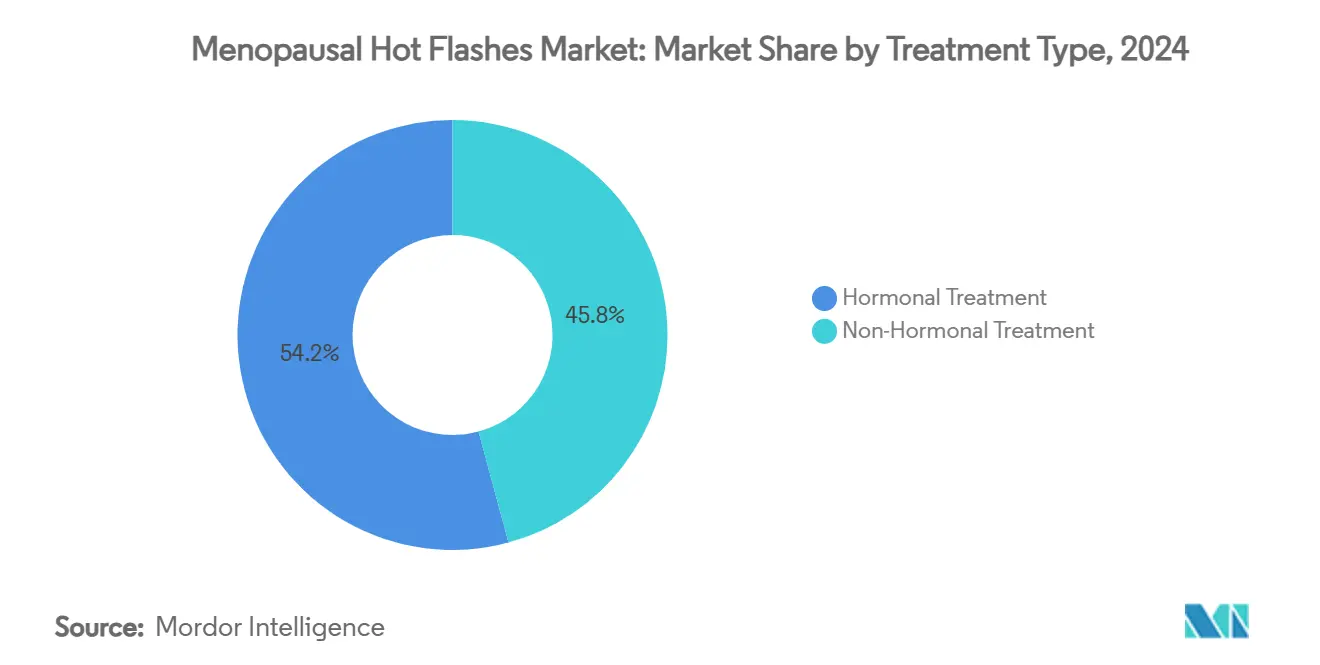
Note: Segment shares of all individual segments available upon report purchase
By Route of Administration: Transdermal Innovation Drives Growth
Oral tablets generated 48.65% of 2024 sales, a clear testament to legacy physician comfort and mature distribution infrastructure inside the menopausal hot flashes market. However, transdermal systems are forecast to record the strongest 7.65% CAGR through 2030, propelled by favorable cardiovascular risk profiles and easier dose tailoring. Transdermal estrogen avoids first-pass hepatic metabolism, reducing thrombotic risk and making it a default recommendation for women with obesity or smoking histories. Market entrants such as MenoPatch allow clinicians to adjust dosing within 3-4 weeks, slashing the trial-and-error period that often frustrates adherence.
Injectable and topical formats remain important for niche patient sets requiring tight pharmacokinetics or combination hormone delivery, yet administration complexity and clinic-visit costs limit widespread uptake. Looking ahead, smart patches with Bluetooth-enabled adherence tracking could push transdermal adoption even higher, especially once payers recognize the long-term savings tied to cardiovascular safety. The menopausal hot flashes market size tied to transdermal modalities may therefore exceed USD 2 billion by 2030 if current development pipelines stay on schedule.
By Distribution Channel: Digital Transformation Accelerates
Retail pharmacies controlled 46.23% of the menopausal hot flashes market in 2024 thanks to geographic reach and high-trust brand equity with older consumers. Digital channels are fast narrowing the gap, expanding at an 8.23% CAGR via integrated telehealth and mail-order models that combine consult, prescription, and refill in a single click. Midi Health, for example, contracts with major U.S. insurers and routes medication fulfillment to accredited online pharmacies, creating an end-to-end ecosystem that reduces office-visit bottlenecks. Hospital pharmacies cover complex cases—such as oncology patients needing coordinated dosing with endocrine therapy—but high service costs confine them to specialized institutions.
Traditional chains are not standing still; they are adding menopause-certified pharmacists and private counseling booths to defend foot traffic. Some have rolled out subscription-based hormone packs shipped quarterly, blurring brick-and-mortar and e-commerce boundaries. As more women discover digital convenience and discrete delivery, the menopausal hot flashes market industry expects online penetration to double its 2024 base by 2030, elevating supply-chain data analytics to a core differentiator for both drugmakers and channel partners.
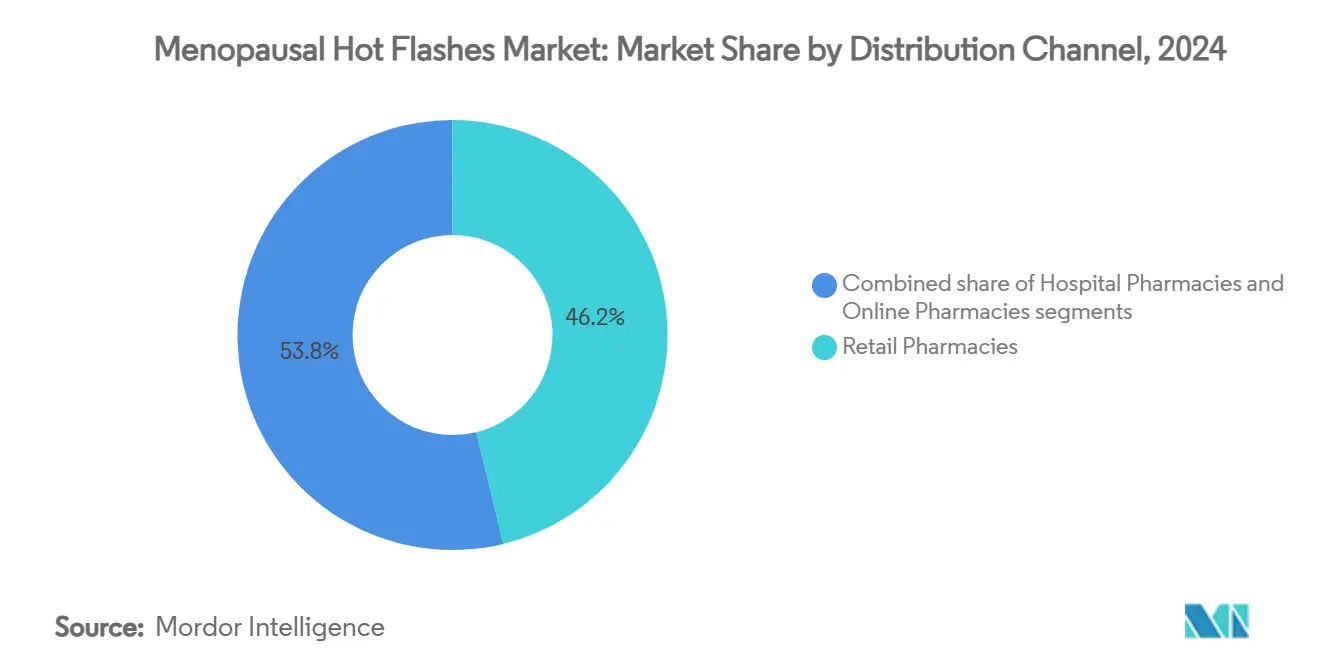
Note: Segment shares of all individual segments available upon report purchase
By Menopausal Stage: Perimenopause Awareness Drives Early Intervention
Post-menopause generated 68.54% of 2024 revenue, confirming its role as the volumetric anchor of the menopausal hot flashes market. Yet perimenopause treatments are showing the fastest 7.85% CAGR as awareness programs stress the value of early intervention in mitigating downstream comorbidities such as osteoporosis and metabolic syndrome. Clinically, initiating therapy within 10 years of the final menstrual period maximizes cardiovascular and cognitive benefit-risk balance, a message now embedded in updated North American Menopause Society guidelines.
Technology is catalyzing this shift. IdentifyHer’s wearable sensor captures skin-conductance spikes correlated with hot flashes, giving both patients and clinicians objective metrics to trigger timely therapy. The commercial ripple effect is notable: earlier diagnosis extends treatment duration by several years, lifting cumulative lifetime value per patient. If current education campaigns sustain momentum, the menopausal hot flashes market size attributed to the perimenopause cohort could add more than USD 1 billion in incremental revenue by 2030.
Geography Analysis
North America accounted for 42.54% of menopausal hot flashes market revenue in 2024, underpinned by favorable reimbursement, high diagnosis rates, and rapid incorporation of non-hormonal launches. FDA approvals of fezolinetant and ongoing review of elinzanetant keep the region at the forefront of therapeutic adoption. Employers are quantifying productivity losses at USD 1.8 billion annually, prompting HR departments to fund menopause benefits, which in turn elevate prescription volumes. Canada mirrored U.S. momentum, granting regulatory clearance for Veozah in 2024 and aligning payer coverage across provinces, while Mexico’s expanding middle class is improving private-insurance penetration, albeit from a low base.
Asia-Pacific is the fastest-growing theater at a 6.45% CAGR thanks to demographic scale and gradual erosion of cultural stigma. Japan runs dedicated menopause centers that provide multidisciplinary care, an approach spurred by data showing USD 12 billion in annual productivity losses from unmanaged symptoms. China houses an estimated 280 million menopausal women, yet treatment penetration remains just 5.66%, suggesting outsized headroom for growth as telehealth and low-cost generics gain traction. Australia’s Pharmaceutical Benefits Scheme addition of three therapies in 2025 slashed out-of-pocket expense by up to 90%, setting a policy template other APAC markets may emulate.
Europe sustains moderate expansion as universal healthcare cushions patient costs and EMA reviews streamline pan-regional launches. Supply interruptions in oral estrogen products have opened white-space for innovative patches and gels, while corporate wellness programs in the United Kingdom now reimburse virtual menopause consults, echoing North American trends. Middle East & Africa and South America remain underpenetrated but show improving fundamentals: urbanization, rising female labor-force participation, and digital-health pilots are making hot-flash therapy more accessible. However, limited insurance frameworks and cultural conservatism still temper near-term uptake, keeping regional share below 10% of the menopausal hot flashes market through 2030.
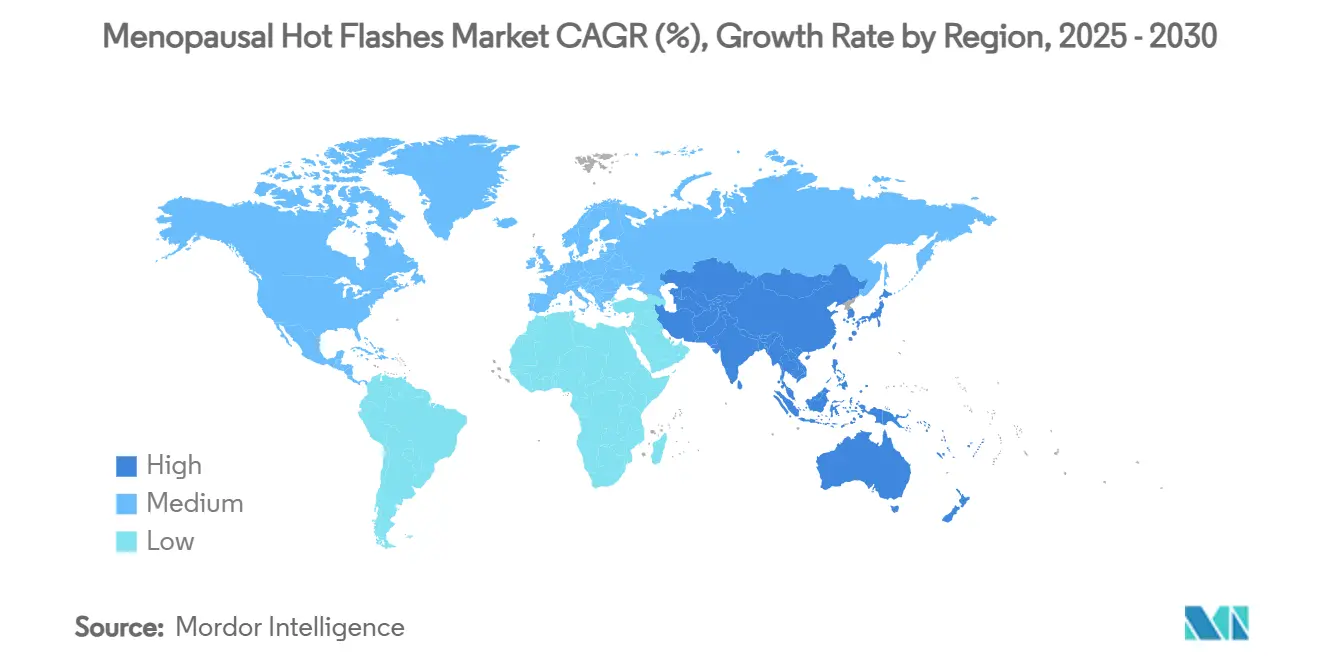
Competitive Landscape
The menopausal hot flashes market is moderately concentrated, with the top five players collectively controlling an estimated 52% of global revenue. Astellas capitalized on first-to-market timing for fezolinetant, yet the firm’s revised sales guidance and Super Bowl advertising outlay reveal the cost of sustaining mindshare in a fast-crowding field. Bayer’s dual-mechanism elinzanetant could redraw competitive boundaries if dual NK-1/NK-3 blockade delivers the hypothesized sleep and mood benefits documented in Phase III OASIS trials. Pfizer and Eli Lilly have entered the conversation through licensing and equity stakes in early-stage NK-3 assets, signaling broader Big-Pharma convergence on the category.
White-space innovation is not limited to molecules. Midi Health’s USD 101 million Series B raise demonstrates investor belief in integrated care models that marry teleconsultation with precision dosing. Device companies such as IdentifyHer and Medherant are courting pharma partners with IP-protected wearables and adhesive technology, respectively, creating bundled-solution potential. Meanwhile, Cosette Pharmaceuticals’ acquisition of Mayne Pharma’s women’s health unit underscores a parallel roll-up strategy aimed at manufacturing scale and formulary breadth. Collectively, these maneuvers indicate that future market leadership will hinge on a mix of novel pharmacology, digital reach, and supply-chain resilience rather than on drug patents alone.
Menopausal Hot Flashes Industry Leaders
-
Bayer AG
-
Novartis AG
-
Pfizer, Inc
-
AbbVie Inc.(Allergan Plc)
-
Novo Nordisk A/S
- *Disclaimer: Major Players sorted in no particular order
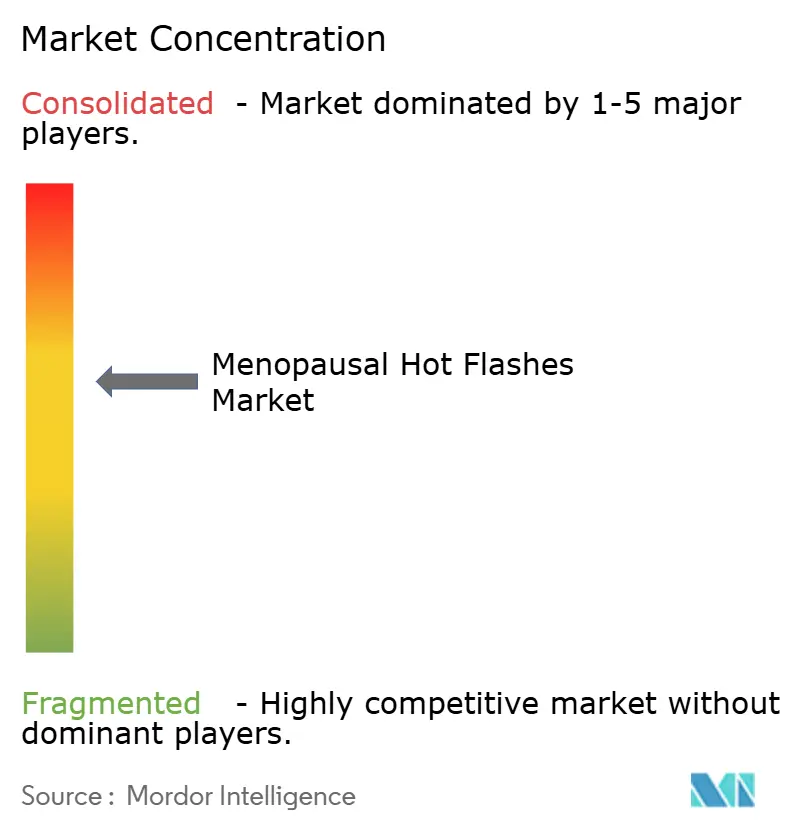


Recent Industry Developments
- July 2025: The FDA extended its elinzanetant review by up to 90 days to analyze Phase III OASIS data in depth.
- February 2025: Cosette Pharmaceuticals acquired Mayne Pharma’s women’s health assets for USD 430 million, adding 12 patent-protected products.
- January 2025: Bayer reported positive OASIS 4 data showing elinzanetant significantly reduced hot-flash frequency in women on endocrine therapy.
- December 2024: Health Canada approved Veozah, expanding non-hormonal choice beyond the U.S.
- October 2024: The FDA accepted Bayer’s NDA for elinzanetant with a PDUFA action date set for Jul 26 2025.
- February 2024: TherapeuticsMD and Mayne Pharma launched estradiol/progesterone capsules in Canada.
Global Menopausal Hot Flashes Market Report Scope
Menopausal hot flashes are the symptoms of menopause. They refer to uncomfortable feelings of warmth occurring during the menopause transition. Hot flashes are the most common symptom of perimenopause, a condition where ovaries gradually make less estrogen.
The menopausal hot flashes market is segmented by treatment type (hormonal treatment [estrogen, progesterone, and estrogen-progesterone combination] and non-hormonal treatment [antidepressant and other non-hormonal treatments]) and geography (North America, Europe, Asia-Pacific, Middle East and Africa, and South America). The report offers market sizes and forecasts in terms of value (USD) for all the above segments.
| Hormonal Treatment | Estrogen |
| Progesterone | |
| Estrogen-Progesterone Combination | |
| Non-Hormonal Treatment | NK-3 Receptor Antagonists |
| SSRIs | |
| SNRIs | |
| Gabapentinoids | |
| Herbal & Dietary Supplements |
| Oral |
| Transdermal |
| Parenteral (Injectable) |
| Topical (Gel/Cream) |
| Hospital Pharmacies |
| Retail Pharmacies |
| Online Pharmacies |
| Perimenopause |
| Post-Menopause |
| North America | United States |
| Canada | |
| Mexico | |
| Europe | Germany |
| United Kingdom | |
| France | |
| Italy | |
| Spain | |
| Rest of Europe | |
| Asia-Pacific | China |
| Japan | |
| India | |
| Australia | |
| South Korea | |
| Rest of Asia-Pacific | |
| Middle East & Africa | GCC |
| South Africa | |
| Rest of Middle East & Africa | |
| South America | Brazil |
| Argentina | |
| Rest of South America |
| By Treatment Type | Hormonal Treatment | Estrogen |
| Progesterone | ||
| Estrogen-Progesterone Combination | ||
| Non-Hormonal Treatment | NK-3 Receptor Antagonists | |
| SSRIs | ||
| SNRIs | ||
| Gabapentinoids | ||
| Herbal & Dietary Supplements | ||
| By Route Of Administration | Oral | |
| Transdermal | ||
| Parenteral (Injectable) | ||
| Topical (Gel/Cream) | ||
| By Distribution Channel | Hospital Pharmacies | |
| Retail Pharmacies | ||
| Online Pharmacies | ||
| By Menopausal Stage | Perimenopause | |
| Post-Menopause | ||
| Geography | North America | United States |
| Canada | ||
| Mexico | ||
| Europe | Germany | |
| United Kingdom | ||
| France | ||
| Italy | ||
| Spain | ||
| Rest of Europe | ||
| Asia-Pacific | China | |
| Japan | ||
| India | ||
| Australia | ||
| South Korea | ||
| Rest of Asia-Pacific | ||
| Middle East & Africa | GCC | |
| South Africa | ||
| Rest of Middle East & Africa | ||
| South America | Brazil | |
| Argentina | ||
| Rest of South America | ||


Key Questions Answered in the Report
How fast is the pharmaceutical spray drying market expected to grow to 2030?
The market is projected to expand from USD 7.62 billion in 2025 to USD 9.27 billion by 2030, reflecting a 5.02% CAGR.
Which formulation segment generates the highest revenue?
Small-molecule APIs hold the largest revenue slice at 47.54% share in 2024, supported by widespread use of amorphous solid dispersions.
What drives Asia-Pacific's outsized growth?
Rising CDMO capacity, government incentives for advanced manufacturing, and local demand for innovative formulations push Asia-Pacific toward a 6.34% CAGR.
Why are CDMOs crucial for spray drying adoption?
Specialized CDMOs supply capital-intensive equipment and technical know-how, letting sponsors access rotary or closed-loop dryers without large upfront investment.
How does continuous manufacturing benefit spray-dried products?
Integrated lines like GEA's ConsiGma shrink waste, shorten scale-up timelines, and maintain real-time process control for consistent quality.
What challenges inhibit broader uptake?
High capital expenditure and extensive GMP validationÑoften lasting up to 18 monthsÑremain the primary hurdles for smaller firms.
Page last updated on:
